Austrian colonial policy
From the 17th century through to the 19th century, the Habsburg Monarchy, Austrian Empire, and Austro-Hungarian Empire made a few small short-lived attempts to expand colonial trade through the acquisition of factories. All attempts were ended due to international pressure, or lack of interest from the Imperial government and opposition from Hungarians high in the government.
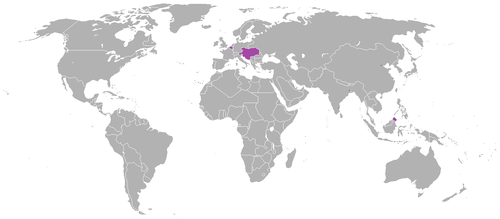
However for a brief period Austria's ruler also ruled Spain, which did have a large colonial empire. No other Austrians were involved when Emperor Charles V held the crown of both the Spanish Empire and Holy Roman Empire.
Ostend East India Company
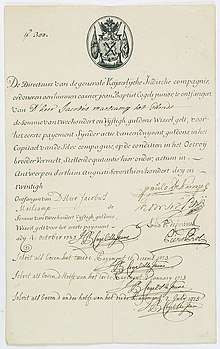
The Ostend East India Company was a private merchant company formed in 1715, based in the Southern Netherlands in what is now Flemish Belgium. No Austrians were involved. The only connection to Austria was that Emperor Charles VI controlled both the Southern Netherlands and Austria. The Emperor provided the company with 6 million guilders, as a public-private monopoly with 6000 shares, set a 1000 guilders each.[1] Due to the speed of the Ostender's trade ships, the Company, within a couple of years became one of the largest trading firms in the East and Canton.[1] By 1720, the Ostend Company had been transporting 7 million pounds of tea, which was about 41.78% of the tea traded from the Port of Canton.[2][1]
The private Ostend Company consisted of two Flemish brothers-in-law, Paulo Cloots and Jacomo de Pret, who formed a consortium with two Dutch merchant houses of De Bruyn and Geelhand; Cloots and de Pret also invited the two London houses of Hambly and Trehee, and the French baker Antoine Crozat to invest in the company.[1] After seven years of profitable ventures, and much fighting between other merchants in Antwerp and Ghent, Charles VI agreed to its petition of official charter.[1]
In 1715, the Ostend Company acquired trading charters in the ports of Mocha, Surat, and Canton.[2] In 1723, the Ostender's obtained trading ports in the lucrative harbors of Banquibazar and Cabelon.[3] The trade missions to Mocha were initially successful, but due to the wreck of the Mochaman, a trade vessel headed to the Red Sea in 1720, and the capture of a home-bound vessel by the Barbary Pirates in 1723, Mocha eventually turned into a heavy loss.[1] The ports of Surat and Canton however, continued to be quite profitable. All the profits went to Belgium and none to Austria.
The company had become such a threat to British, Dutch, Portuguese, and French interests, that when Emperor Charles VI promulgated the edict of the Pragmatic Sanction of 1713, it was refused international recognition on the grounds of Ostend Company's success in the East Indies. These International political pressures ended its extraordinary growth, and in 1727 the charter was suspended, leading to the company being dissolved by 1732.
After the Imperial government's withdrawal of the Ostend Company's charter, the Great Powers accepted the Pragmatic Sanction. The suspension also allowed the Austrians to sign the Treaty of Vienna (1731) with the British; which allied both powers in the Anglo-Austrian Alliance.[1]
_Affairs...%22.jpg)
Attempt in Delagoa Bay
In 1776, an expelled British trade official, Colonel William Bolts, approached the Austrian Imperial Court with a request to found a trading company to explore possible routes in Africa, India, and China.[4] Empress Maria Theresa was intrigued and decided to form the Austrian Asiatic Company of Trieste, with Bolts as the head of the company. Colonel Bolts had previously been under the service of the British East India Company and was already competent in trade and colonization efforts. Bolts had also heard that the area was a possible site for gold mining.[5]

Sailing from Flanders in 1778, Bolts and his company of Austrian-Italian subjects, docked in Delagoa Bay. Bolts then made treaties with the local Mabudu chieftains, who inhabited the port.[6] A trading post (factory) was built, and the factory quickly began to thrive under Austrian rule. Bolts shortly after, set sail to promote Austria interests in India. After two years, the factory, which was composed of 155 men and a number of women, traded in ivory, and profits reached as high as 75,000 pounds per year.[7]
The Austrian presence in Delagoa Bay caused the ivory price to change dramatically. This was due to the Austrian output, which exceeded that of the Portuguese in Mozambique Island.[4] Unfortunately for the Austrians, the port contracted malaria in 1781, and the Portuguese successfully asserted their dominance of the area; the Portuguese then proceeded to expel the remainder of Austrian colonists.[6]
Multiple attempts in the Nicobar islands
First attempt
After Bolts' mission in Delagoa Bay, he directed a venture to the Nicobar Islands. This mission was a part of his colonial ventures in India; and in 1778, Gottfried Stahl and his crew arrived on the ship Joseph und Theresia.[8] Stahl greeted the natives personally and made a contract with the Nicobarese, where all twenty-four islands were to be signed over to the Austrians. The colonization effort was successful until Stahl, which Bolts had appointed as head of the colony, died in 1783. The colonists lost courage in their settlement attempts, and the islands were abandoned in 1785.[8]
Second attempt and expedition
Seventy-three years later in 1858, the SMS Novara, then on its circumnavigation of the globe, decided to sail to Nicobar. SMS Novara landed in Car Nicobar, the northernmost island, and its purpose was to promote scientific exploration and included the search for possible penal colonies.[8] The leader of the group, Karl von Scherzer, promoted re-colonization. Austrian scientists and archaeologists then explored the islands of Nancowry and Kamorta and collected over 400 artifacts native to the islands.[8] The Austrian government decided against Von Scherzer's recommendations, and closed all potential colonial opportunities.
Third attempt
In 1886, the Austrians became interested in another possible colonization attempt. When the crew arrived on the island of Nancowry with the corvette SMS Aurora, they were surprised to find the entire Nicobar island chain had been colonized by the British several years earlier.[8] In 1868, the British purchased the claims to the Nicobar Islands from the Danish and established it as a penal colony for several years.[9] This ended all further possibilities to colonize the area.
Exploration of Franz-Joseph's Land
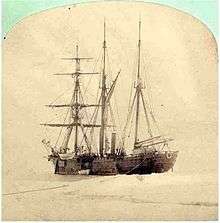
In 1873, an Austrian expedition, according to its leader Julius von Payer, was sent to the North Pole tasked with finding the Northeast Passage.[10] The expedition actually ended up close to the Novaya Zemlya archipelago, the easternmost point of Europe. Karl Weyprecht, the expedition's secondary leader, claimed the second intended destination after the Northeast Passage was the North Pole.[11]
The cost of the journey is estimated to be around 175,000 florins. The project was promoted and financially supported by several Austrian and Hungarian noblemen, which included Count Johann Nepomuk Wilczek and Count Ödön Zichy.[12] The head-ship was named after the Admiral Wilhelm von Tegetthoff. The Tegetthoff weighed 220 tonnes, 125.78 feet long (38.34 m.), and had a 100 horsepower (75 kW) steam engine).[13]
The Tegetthoff left port at Tromsø, Noway in July 1872. Soon after arriving in the Arctic Circle, the Tegetthoff became locked in pack ice and drifted for the remainder of their journey.[10] While drifting within the ice, the explorers discovered an archipelago and decided to name it after the then-current Emperor Franz Joseph. The crew later was able to dock and performed several sled expeditions on the island chain.[12]
Two years later in May 1874, Captain Weyprecht decided to abandon the ice-locked Tegetthoff and believed the crew could return to the mainland by sleds and boats.[11] On 14 August, the expedition reached the open sea. The expedition then arrived at Novaya Zemlya, where a Russian fishing vessel rescued them. The crew was dropped off in Vardø, Norway; and were able to arrive in Austria-Hungary by train from Hamburg.[10]
Berlin Conference of 1884–85
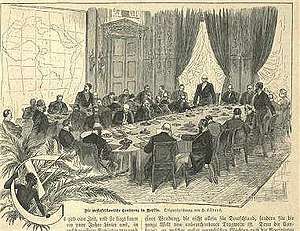
The Berlin Conference was held to settle matters of African colonization, particularly regarding the Congo territory and West Africa. Austria-Hungary was only invited to the Conference due to its status as a Great Power.[14] While Austria did not petition for any permanent colonies or treaty ports, it did acquire some indirect benefits. Emerich Széchényi von Sárvári Felsö-Vidék, serving as one of the head members of the Conference, was able to procure the privilege of free docking rights in all European African ports, excluding British South Africa, Italian Somalia, and French Madagascar. Austria-Hungary was further able to sign trade agreements consisting of colonial goods from Africa, with several of the other powers present.
19th-century colonial possibilities
Rio de Oro
After the humiliation in the Spanish–American War, Spain wished to divest itself of its colonies, and Spanish diplomats approached the Austro-Hungarian Colonial Society about a possible purchase of the trading port of Rio de Oro. The society's vice-president, Ernst Weisl, made a quiet deal with Agenor Goluchowski, the Minister of Foreign Affairs for Austria.[15] Goluchowski later convinced the Austrian Imperial Council, and Emperor Franz Joseph openly supported the deal. A treaty was drawn up to purchase and transfer ownership over to Austria-Hungary. However, the Hungarian House of Magnates blocked the colonial purchase on the eve of its finalization.[15]
This colonial move made by the Austrians was primarily to justify the naval aspirations of several Austrian ministers. The Hungarian Parliament had been for some time opposed to naval expansion, and the Austrians had slowly been pressuring the Hungarians for increased naval expenditures in the national budget.[15] With the Hungarian veto of this purchase, this ended further potential colonial expansion and ideas of dramatic naval expansion in Austria-Hungary.
Port of Tianjin
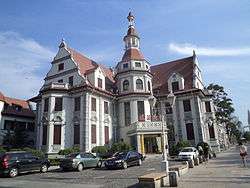
Austria-Hungary participated in the Eight-Nation Alliance from 1899-1901. This grand alliance was formed to contain the Boxer Rebellion in China.[16] The Austro-Hungarian Navy helped in suppressing the rising. However, Austria-Hungary sent the smallest force of any nation. Only four cruisers and a force of only 296 marines were dispatched.[17]
Even so, on 27 December 1902, Austria gained a concession zone in Tianjin as part of the reward for its contribution to the Alliance.[18][19] The Austrian concession zone was 150 acres (0.61 km2) in area; which was slightly larger than the Italian, but smaller than the Belgian zone. The self-contained concession had its own prison, school, barracks, and hospital.[18] It also contained the Austro-Hungarian consulate and its citizens were under Austrian, not Chinese, rule.[18]
The concession was provided with a small garrison, and Austria-Hungary proved unable to maintain control of its concession during the Great War. The concession zone was swiftly occupied on the Chinese declaration of war on the Central Powers.[18] On 14 August 1917 the lease was terminated, (along with that of the larger German concession in the same city).
Austria abandoned all claims to Tianjin on 10 September 1919.[20] Hungary also made a similar recognition in 1920.[20] However, despite its relatively short life-span of 15 years, the Austrians left their mark on that area of the city, as can be seen in the Austrian architecture that still stands in the city.[21]
List of consuls
- Carl Bernauer: 1901–1908
- Erwin Ritter von Zach: 1908
- Miloš Kobr: 1908–1912
- Hugo Schumpeter: 1913-1917
See also
References
- Gale, Thompson (2006). "Ostend East India Company". Encyclopedia. Archived from the original on 2006. Retrieved December 16, 2018.
- Davids, Karel (November 1993). "Jaap R. Bruijn and Femme S. Gaastra, Ships, Sailors and Spices: East India Companies and their Shipping in the 16th, 17th and 18th Century. Amsterdam (NEHA) 1993. XI + 208 pp. ISBN 90-71617-69-6". Itinerario. 20 (3): 147. doi:10.1017/s0165115300004046. ISSN 0165-1153.
- Parmentier, Jan (December 1993). "The Private East India Ventures from Ostend: The Maritime and Commercial Aspects, 1715–1722". International Journal of Maritime History. 5 (2): 75–102. doi:10.1177/084387149300500206. ISSN 0843-8714.
- Kloppers, Roelie J. (2003). "THE HISTORY AND REPRESENTATION OF THE HISTORY OF THE MABUDU-TEMBE". SUNScholar Research Repository. Retrieved December 2018. Check date values in:
|access-date=(help) - C., F. R.; Bryant, A. T. (January 1930). "Olden Times in Zululand and Natal, Containing Earlier Political History of the Eastern Nguni Clans". The Geographical Journal. 75 (1): 79. doi:10.2307/1783770. ISSN 0016-7398. JSTOR 1783770.
- Liesegang, Gerhard (1970). "Nguni Migrations between Delagoa Bay and the Zambezi, 1821-1839". African Historical Studies. 3 (2): 317–337. doi:10.2307/216219. ISSN 0001-9992. JSTOR 216219.
- D., Newitt, M. D. (1995). A history of Mozambique. Bloomington: Indiana University Press. ISBN 978-0253340061. OCLC 27812463.
- Steger, Philipp (2005). "The Nicobar Islands: Linking Past and Future". University of Vienna. Archived from the original on 2005. Retrieved December 16, 2018.
- Lowis,R. F. (1912) The Andaman and Nicobar Islands. Part I. Report. Part II. Tables.
- von Payer, Julius (1876). New Lands within the Arctic Circle. England: Cambridge University Press. ISBN 9781139151573.
- Weyprecht, Karl (1875). The Austro-Hungarian Expedition of 1872-1874. Austria. ISBN 9783205796060.
- Johan., Schimanski (2014). Passagiere des Eises Polarhelden und arktische Diskurse 1874. Spring, Ulrike. (1. Aufl ed.). Wien: Böhlau Wien. ISBN 9783205796060. OCLC 879877160.
- Johan., Schimanski (2014). Passagiere des Eises Polarhelden und arktische Diskurse 1874. Spring, Ulrike. (1. Aufl ed.). Wien: Böhlau Wien. ISBN 9783205796060. OCLC 879877160.
- "MITTEILUNG V. Berliner Konferenz "Die Persönlichkeit in der Wissenschaft"". Deutsche Zeitschrift für Philosophie. 33 (7). 1985-01-01. doi:10.1524/dzph.1985.33.7.672. ISSN 2192-1482.
- Sondhaus, Lawrence (1994). The Naval Policy of Austria-Hungary, 1867-1918: Navalism, Industrial Development, and the Politics of Dualism. Purdue University PRess. pp. 147, 148. ISBN 9781557530349.
- Hall Gardner (16 March 2016). The Failure to Prevent World War I: The Unexpected Armageddon. Routledge. p. 127. ISBN 978-1-317-03217-5.
- "Russojapanesewarweb". Russojapanesewar.com. 1 July 1902. Retrieved 6 September 2012.
- Bristol, University of. "Bristol University | Tianjin under Nine Flags, 1860-1949 | Austro-Hungarian Concession". www.bristol.ac.uk. Retrieved 2018-12-22.
- Jovanovic, Miloš (2017). "Tianjin's Imperial Discomfort". www.mmg.mpg.de. Archived from the original on 2018-12-23. Retrieved 2018-12-23.
- Santangelo, Jon. "A 5 Minute History of the 10 Concessions of Tianjin". Culture Trip. Retrieved 2018-12-23.
- "China VII: Concessions in China - Nine Concessions in Tianjin". www.travelanguist.com. Retrieved 2018-12-23.
Further reading
- Sauer, Walter. ‘’Habsburg Colonial: Austria-Hungary's Role in European Overseas Expansion Reconsidered,” Austrian Studies (2012) 20:5-23 ONLINE